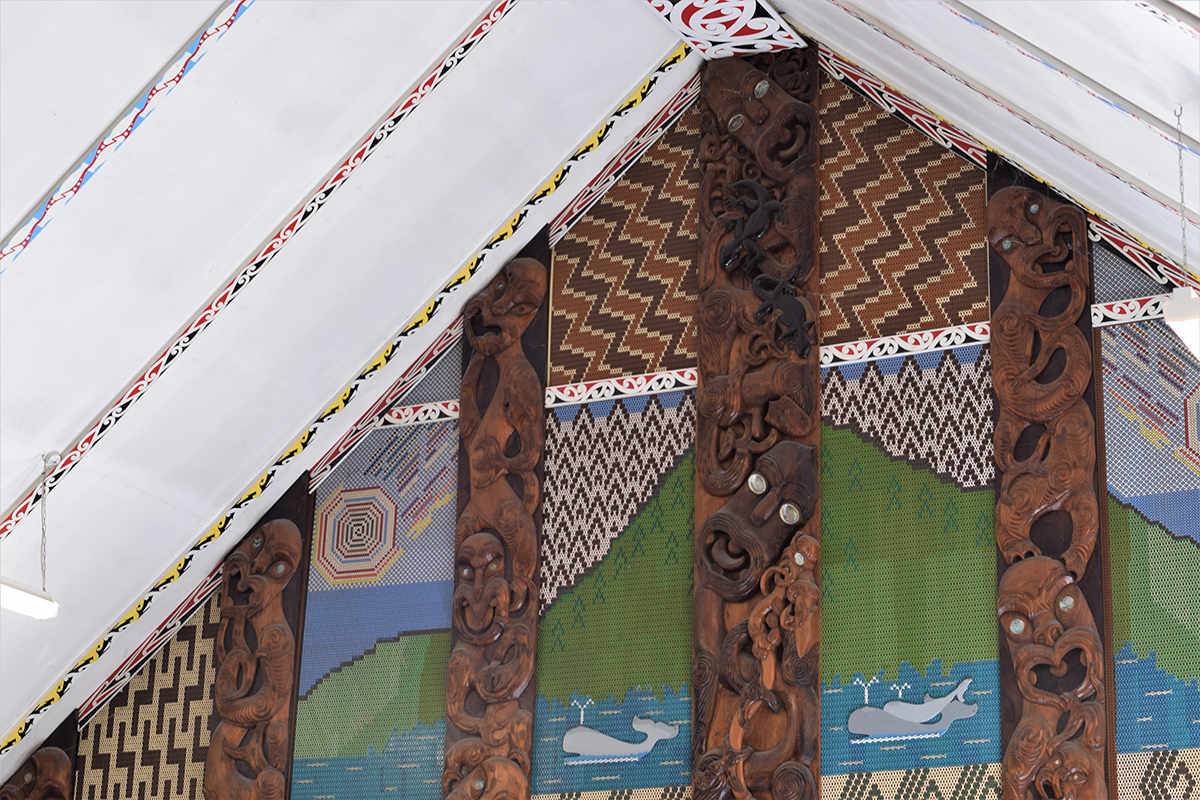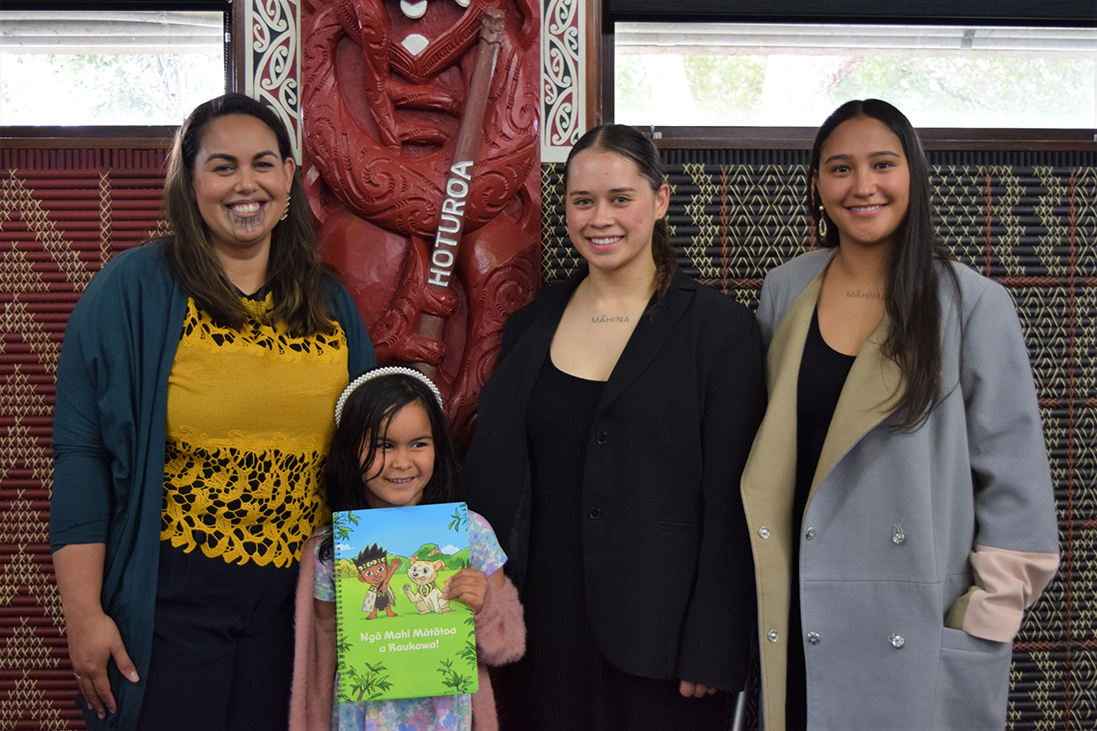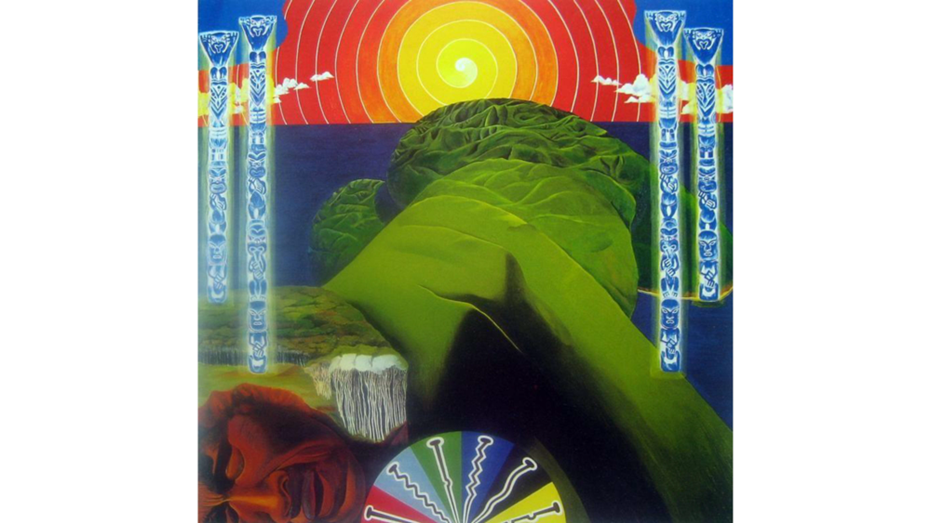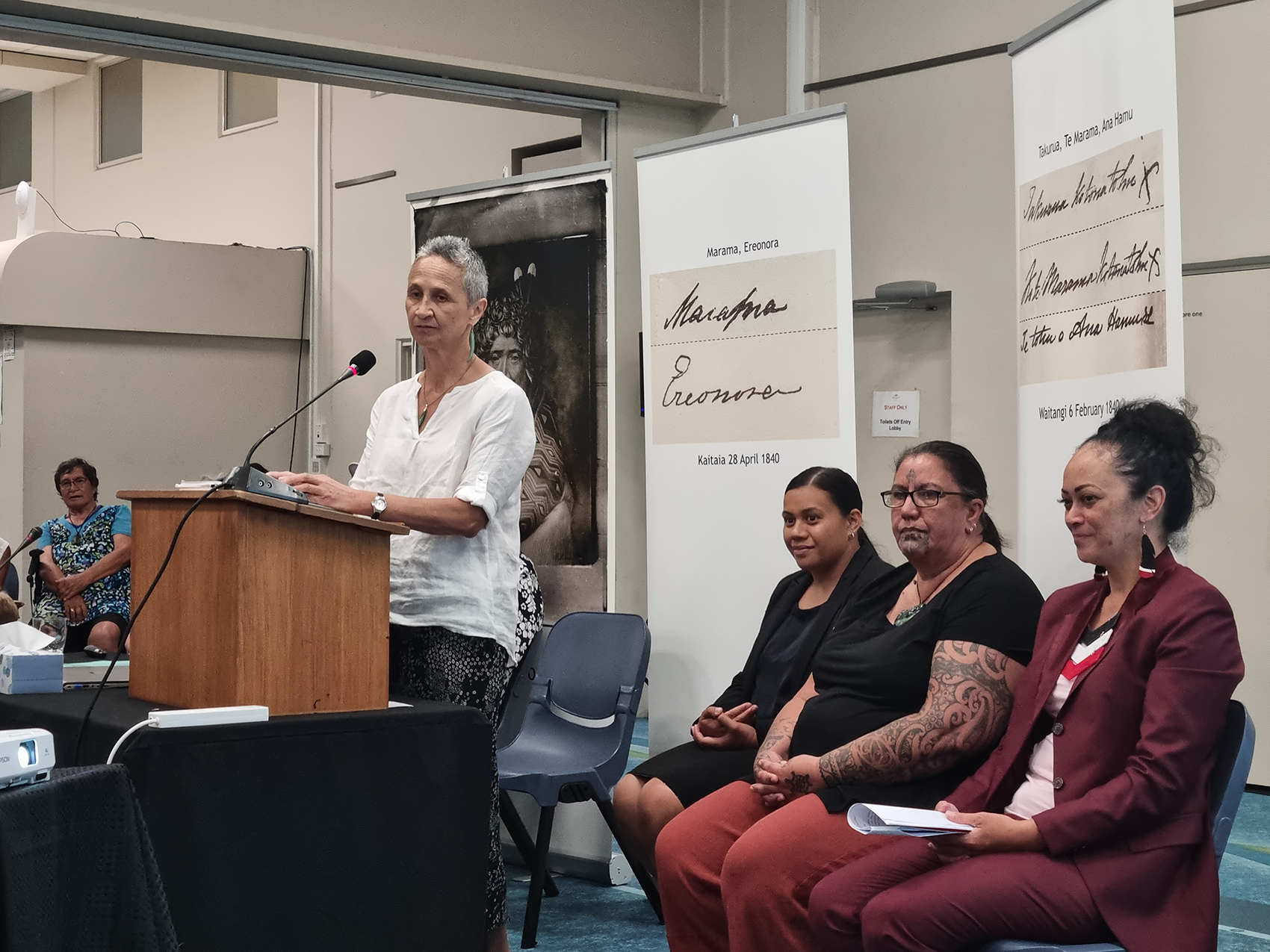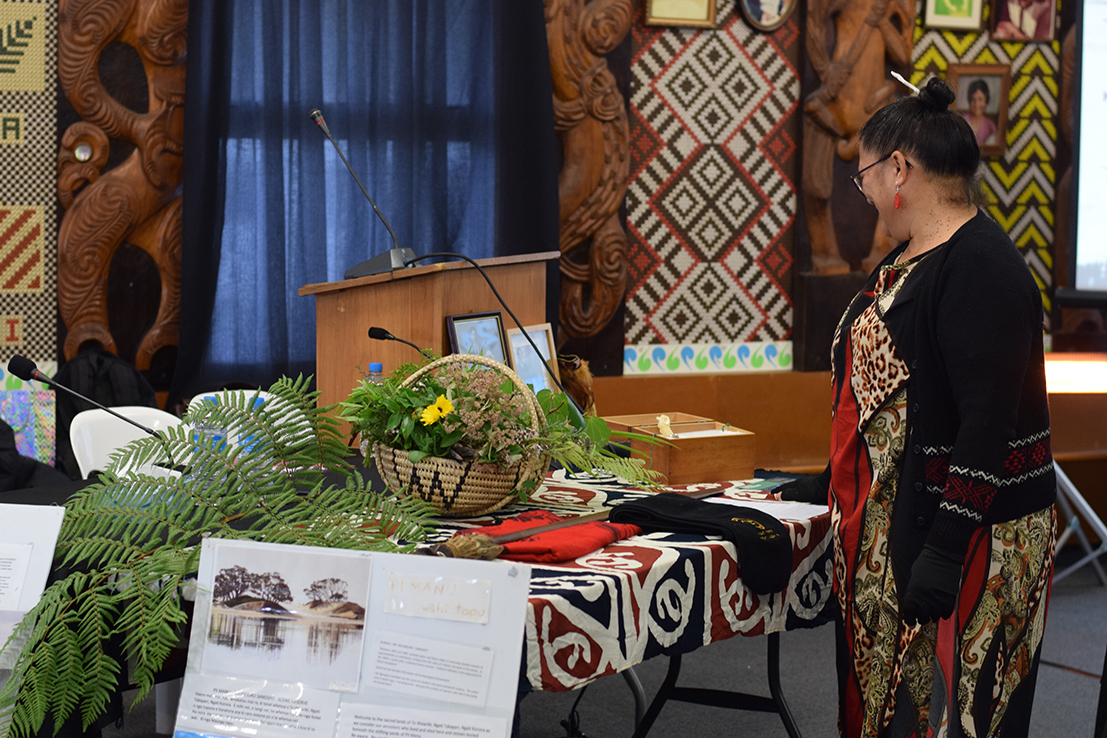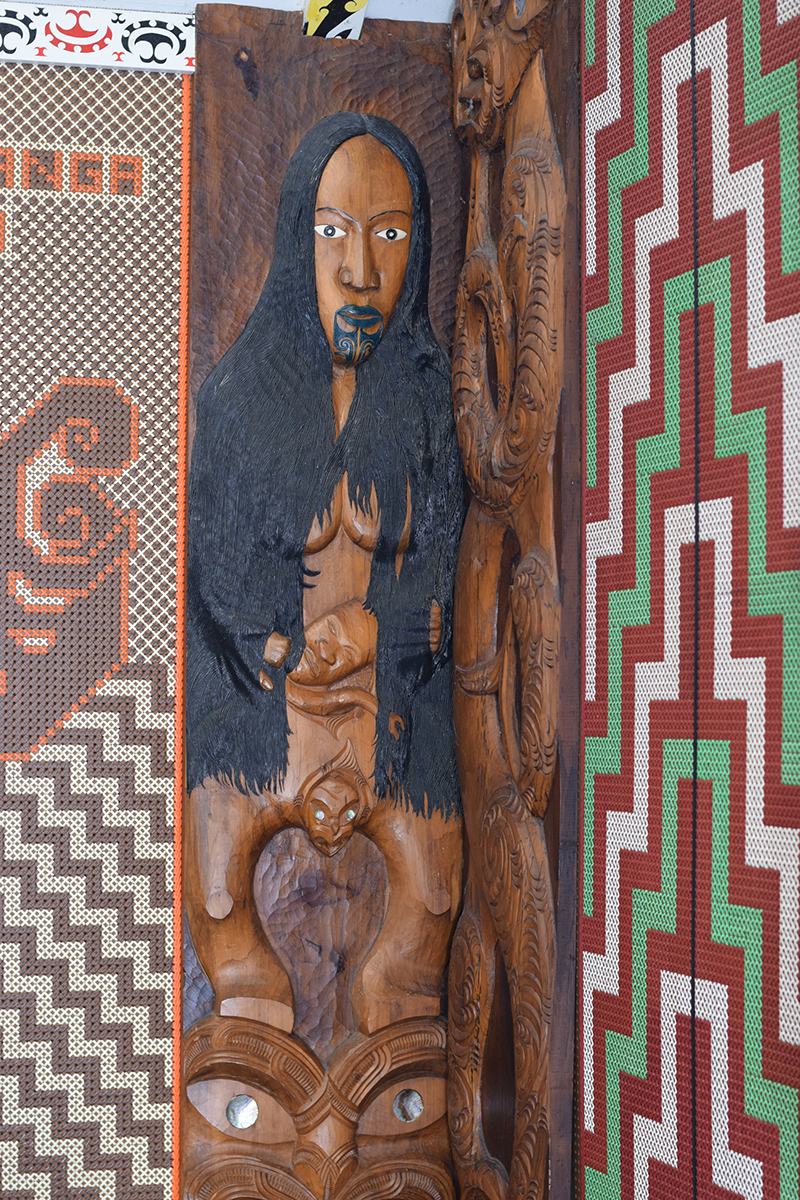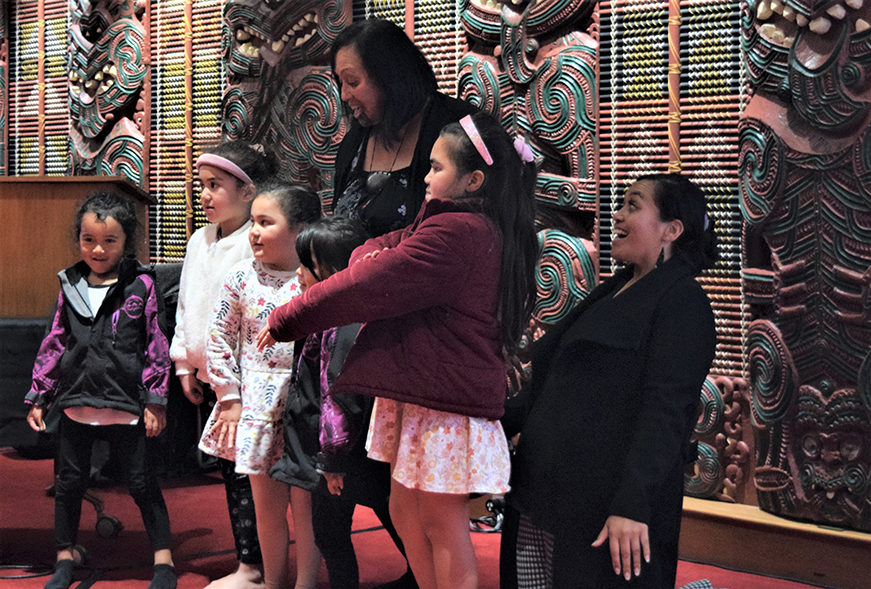The role of wāhine Māori in holding and transferring mātauranga, including tapu knowledge
Ko tā te wāhine Māori mahi ki te pupuri me te tuku i ngā mātauranga, tae atu hoki ki te mātauranga e tapu ana
Witnesses explained that mātauranga Māori was transmitted through oral tradition, encompassing waiata, karakia, stories, art, and music. Wāhine Māori held a pivotal role as custodians of this tapu knowledge, transferring it through the many oral forms, as well as through raising tamariki. Many witnesses themselves embodied this role when they presented their evidence at hearings, often with large groups of mokopuna present. In their presentations to the Tribunal, several witnesses honoured taonga and the mātauranga they embodied and represented. Witnesses also spoke about wāhine roles in weaving, as tohunga, karakia, and waiata.
Witnesses also emphasised that particular knowledge and practices were the domain of wāhine and reinforced their mana – particularly those related to te whare tangata and karanga. Witnesses drew on examples from the lives of their tūpuna (read more stories of tīpuna wāhine), and highlighted the roles of whāea and kuia in atua narratives. Witnesses also explained how possessing tapu knowledge enhanced the mana of wāhine.
However, witnesses had differing views on whether wāhine could use the mātauranga they held or transmitted. Some said, in the case of certain mātauranga, wāhine could not use it or only in particular circumstances (Patricia Tauroa, doc A60(external link); Materangatira Lily Porter, doc A16(a)(external link); Robyn York, doc A65(external link)). Nonetheless, many other witnesses told of wāhine using a variety of mātauranga and said that mana and circumstances, rather than gender, shaped the relationships that communities had to mātauranga.
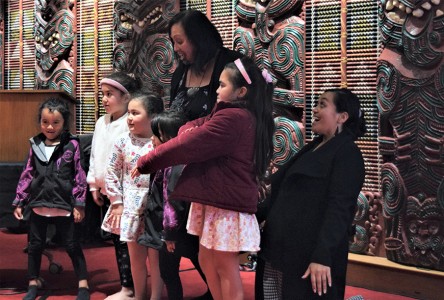
Waitangi Black pictured with mokopuna at Te Mānuka Tūtahi Marae, Whakatāne
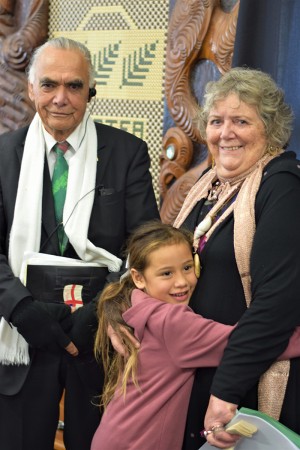
Moe Milne pictured with mokopuna and Hirini Henare (left) at Terenga Parāoa Marae, Whangārei, July 2021
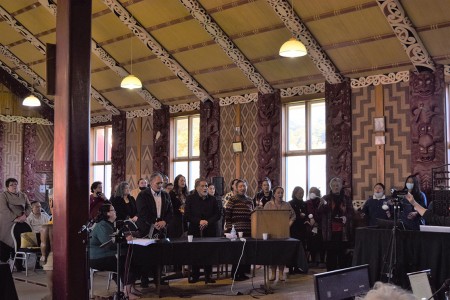
Ripeka Hudson and large rōpū supporting with waiata at Waiwhetū Marae, Lower Hutt, August 2022
See more about what witnesses said about wāhine mātauranga in the areas of:
Key witnesses who gave evidence
Rereata Makiha (doc A71)(external link) told the Tribunal about the roles held by wāhine Māori in traditional society as navigators, keepers of traditional knowledge through whare wānanga, and gardeners. He emphasised that the role of wāhine as gardeners reinforced their mana, as kai was both physically and spiritually significant in pre-colonial Māori society (for instance, ‘food brings people back into the safe state of noa restoring physical and spiritual balance’). He said that, according to iwi and hapū narratives of Hokianga, ‘Kupe’ was not the name of a single individual that discovered Aotearoa but was a general title bestowed on expert navigators. In Hokianga tradition, there were four Kupe – including a woman.
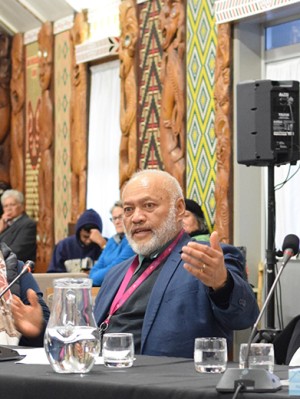
Rereata Makiha giving evidence at Terenga Parāoa Marae, Whangārei, July 2021
Patricia Tauroa (doc A60)(external link) said female and male elders held mātauranga in pre-colonial Māori society and were responsible for determining which mokopuna would inherit certain skills or knowledge – such as māu rakau, rongoā, or whakapapa. The authority of wāhine in determining how kōrero was passed on indicated their mana. She also shared a distinct kōrero, shared with her by master carver Paki Harrison in the 1980s, that wāhine could hold knowledge of practices like carving, but not practice it.
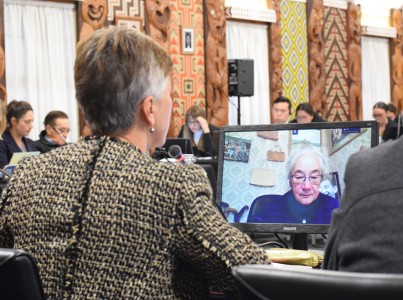
Patricia Tauroa giving evidence virtually, pictured with Judge Sarah Reeves, July 2021
What witnesses said
- “It is my duty, as one of my parents’ eighteen children, to stand in the truth of my tupuna and recall their histories in this Kōrerō Mana Wahine.” (Raiha Ruwhiu, doc A93, p 1)(external link)
- “Traditionally, both wāhine and tāne were navigators of waka and shared some of the same roles on waka. They also held distinct roles. For example, it was only wāhine who could karanga to the moana to communicate with the atua. This role was essential as a waka could not travel anywhere without a passenger who could karanga to the moana.” (Rereata Makiha, doc A71, p 3)(external link)
- “Whare wānanga were traditional places of higher learning. Both wāhine and tāne held traditional knowledge through whare wānanga. Certain mātauranga is connected with te ira wāhine and other mātauranga with te ira tāne. An example of mātauranga particularly associated with te ira wāhine is te taha wairua and connections with mate and the other side (matakite). Wāhine, and especially kuia, are experts at communicating with the other side. They can do this as if the spirits are living in the real world and as if they are having a conversation with them … Wāhine are experts at fare-welling the wairua (spirit) of the mate (dead). A lot of kōrero was passed down through whare wānanga that allowed wāhine to send the wairua of the mate back to the spiritual realm. This included knowledge that everyone has two ira – te ira wāhine and te ira tāne. Te ira wāhine – also known as mareikura – returns to the spiritual realm of Hinenuitepo and the house of Matangireia. Te ira tāne – also known as whatukura – returns to the spiritual realm of Tamanuitera and Ranginui and the house of Rauroha. The puna roimata or the māturuturu roimata – a deep tangi (cry) – was only implanted in te ira wāhine. This type of tangi was important for fare-welling the dead and as an act of healing for whānau.” (Rereata Makiha, doc A71, p 4)(external link)
- “The role of wāhine Māori as gardeners for the production of kai involved significant leadership in managing and controlling the planting, growing and harvesting, sorting and distributing the harvest, and bringing people together to share kai and wānanga to plan for the year ahead.” (Rereata Makiha, doc A71, p 6)(external link)
- “Our mother taught us ‘me tiaki i ngā kaumātua; ngā māra kai. Ko ngā tamariki ngā rangatira, whakarongo ki a rātou kōrero whakamanatia.’ This was like her catch cry that conceptually talks about kaumātua as the knowledge holders to feed the children to make them grow. It also acknowledges the honesty of children and that we need to listen to what they have to say.” (Moe Milne, doc A62, p 4)(external link)
- “The mana accorded master carver Paki Harrison is known throughout Māoridom and by many Pākeha of his generation. In 1983, Paki was engaged with Hiwi in the carving of pou for the New Zealand Embassy building in Beijing. During one of our conversations, I raised the question of women being present while carving was being done. Paki’s response was that, traditionally in many areas of Māori life, a woman was always chosen to learn and carry mātauranga forward, including in the art of carving. He said that, even though she was not taught the physical activity, she would learn the knowledge of ‘how to carve’ – she would hold the knowledge of this and could convey the essential elements of carving to those who would eventually be designated to become carvers. This was done because of the reality, in those earlier generations, that women were less likely to be killed in battle than men, hence they were more likely to live longer and would pass on the knowledge. It was essential that the knowledge of activities, and the mātauranga of it, should be held by someone who would be able to understand, hold, and give it to future generations … Carving is not the only area where women were taught to understand the mātauranga due to the factor that they were less likely than men to be killed in battle. The practice is not unusual although it largely depended on the tikanga of the people themselves. In some areas, women were taught mau rakau – a skill essential for those going into battle. This practice is an indication that Māori pre-1840 believed and understood the need for ongoing teaching of their tikanga, their principles and practices, if their future generations were to survive. Therefore, women had an essential role in the ability to retain information, to hold mātauranga over several years before imparting it to those who were the right people to learn the skill.” (Patricia Tauroa, doc A60, pp 7-8)(external link)
- “As some wāhine Māori have said during our Tribunal hearings presentations, ‘I tupu ake ahau i raro i ngā panekoti ō taku kuia (I was brought up under the skirts of my grandmother).’ This means that they were kept close to their grandmother or mother, in order that they learn those things that the grandmother wanted them to learn. It also indicated that she was kept away from the things that the grandmother may not have wanted her to learn. This was a method of teaching by hearing and seeing from which would come understanding … All kaumatua, male and female, are the keepers of knowledge. Some kaumatua and kuia even today, choose to take a young person beside them to teach them mātauranga in areas of life that they are familiar with.” (Patricia Tauroa, doc A60, pp 14-15)(external link)
- “The women of our hapū have been central to the maintenance of our framework of matauranga, cultural practices, our ahi kaa, karakia and te reo on which our beliefs and identity are based.” (Tracy Hillier, doc A92, p 15)(external link)
- “Traditionally, knowledge was passed down orally, by way of the utilisation of mōteatea, puurakau, whakapapa, and haka. Significant historical events were then passed down from generation to generation. Hapū knowledge was entrusted and intertwined into each generation, directly passing that knowledge onto the next generation. The tāne would go to the whare wānanga. Wāhine learnt from the natural environment and being around resources.” (Paihere Clarke, doc A141, p 6)(external link)
- “Wāhine Māori were responsible in transmitting tribal knowledge through waiata (song), haka (ceremonial dance) weaving and artwork, ancient concepts and beliefs to ensure tribal survival and to ensure and protect tribal identity.” (Katarina Jean Te Huia, doc A115, p 12)(external link)
- “Māori traditionally have always had a strong oral literary history. This is evident in whaikōrero, kaikaranga, kōrero paki, whakapapa, whakatauki, waiata, mōteatea, haka and kiwaha, all of which are rich in knowledge.” (Aroha Rickus, doc A140, p 14)(external link)
- “Whāea or kuia are part of the narratives of acts by Māori atua, although their names are rarely stated in the general English documents. An example is the kōrero for Tāwhaki, and his receiving ngā kete mātauranga (‘baskets of knowledge’) from a kuia … It is my opinion that, in the recording of these kinds of kōrero by early researchers, the factor of a female having or carrying mātauranga was deliberately ignored. This would have been on the basis that only males held knowledge and the capacity to educate others. This, for Māori, is far from the reality.” (Patricia Tauroa, doc A60, p 7)(external link)
- “[Wāhine] are the ones who hold the knowledge and pass it on to others. It is not that our men cannot hold that knowledge, it is more that our men have other things to remember or may die.” (Robyn York, doc A65, p 3)(external link)
- “One can surmise from this varied discussion [by early Pākehā ethnographers] about tohunga and whare wānanga that they existed but that certain of them, from particular types or branches of sacred knowledge, may have been exclusively male. But that does not necessarily deny the existence of other types of learning institutions for female tohunga. Nor is there overwhelming evidence that male and female whare wānanga, if they existed, were hierarchically designated, with a superior male form.” (Dr Ella Henry, doc A63, p 9)(external link)
- “Importantly, kuia would normally have passed their intrinsic and learned knowledge, experience and skills to her successors, thereby completing the cycle of life intrinsic to Māori.” (Aorangi Kawiti, doc A24(a), pp 9-10)(external link)
- “Wāhine Māori and Māori males both served as the hapu and iwi repositories and protectors of sacred knowledge and tribal lore, but their functions were distinct.” (Hinemoa Ranginui-Mansell, doc A129, p 3)(external link)
- “There are numerous examples of kōrero i tuku iho that convey the mana that our whāea tūpuna had across multiple contexts, as tohunga karakia, as scholars i te ira wāhine. They held mana over whenua and resources; mana whenua, mana wai, mana moana. They maintained their authority in strategic decision making in kōrero, waiata and through their actions. Their leadership in overseeing and directing te mahi o te pā occurred daily, oversight of kaimahi and mahinga kai, as kaitito of waiata, as holders of esoteric knowledge and maramataka and the practical application of this knowledge. As kai rāranga, as holders and conveyers of mātauranga and whakapapa. As kai karakia, kai karanga and holders and givers of names, as matakite, as rongoa practitioners and knowledge holders ō whakapapa i tuku iho and pūrākau. In their knowledge of places and in their understanding of mātauranga and whare wananga lore, in the retention and conveyancing of this knowledge through generations.” (Stephanie Turner, doc A109, p 3)(external link)
